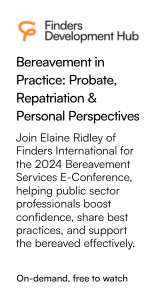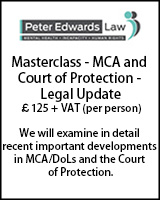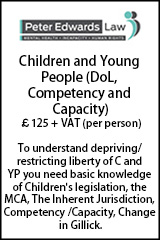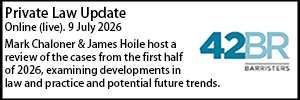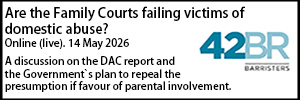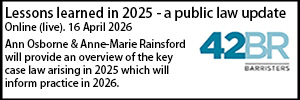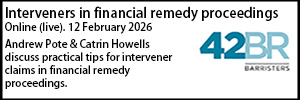Adequacy of reasons and the approach to clarification
- Details
The Court of Appeal has handed down a key ruling on the adequacy of reasons in a judgment in care proceedings, and the approach that should be taken to clarification, writes Jennifer Youngs.
In the case of C, D and E (Care Proceedings: Adequacy of Reasons) [2023] EWCA Civ 334, the Court of Appeal has reiterated the importance of clear and explicit, legal and factual analysis in judgments of first instance in care proceedings; particularly when those proceedings concern applications for orders placing children for adoption. The Court also provides guidance as to the approach to be adopted when seeking further clarification of such judgments.
The case on appeal concerned care orders in respect of three children, C, D and E, and a placement order in respect of E. Proceedings commenced in January 2021 when A and B – elder brothers of the three children subject to the appeal - made allegations that they and their half-brothers C and D had been physically abused by the appellant mother (of C, D and E), and that the father had failed to protect them. The four children were removed from the family home and placed in foster care under interim care orders. In May 2021, the appellant gave birth to E who was also made the subject of care proceedings and placed under an interim care order in a mother and baby residential assessment unit.
Findings were made at a separate fact-finding hearing, that the appellant mother had physically abused the four older children by punching, kicking, slapping and hitting them with a variety of implements, bathing them in cold water, and in respect of A forcing him to stay in his room without food. The recorder found that the father was aware of the mother's abuse of the children but did nothing to stop it. The proceedings were then adjourned for further assessments and listed for a seven-day final welfare hearing in November 2022.
At that welfare hearing, the court found threshold made out in respect of all five children on the basis of the earlier findings (the care plans for A and B not being in dispute). The Court of Appeal then summarises the remainder of the judgment at first instance as follows:
10. At paragraphs 31 to 34, the recorder directed himself on the relevant statutory provisions for the making of a placement order, including the welfare checklist set out in s.1 of the Adoption and Children Act 2002. At paragraph 35, he expressed his thanks to counsel for the guardian and local authority for setting out the case law in their closing submissions. He continued:
"In order not to over-burden those listening to this judgment, I do not propose to set out orally as I have just done in respect of the statutory provisions the case law to which my attention in directed. However, if there is to be a transcript of this judgment, which I suspect is likely, I invite the transcriber to include by way of addendum to this judgment the case law as set out in, I was going to say either of those two documents, but it is helpfully set out, for example, at paragraph six and follows of Ms Barran's position statement, and it may very well be that that is adequate in terms of a recitation of case law for the purposes of this judgment. It is, I should say for the sake of completeness, also set out in paragraph 13, A to E, of Ms Youngs' very helpful submissions."
11. In the event, the transcript of the judgment was prepared in some haste for this appeal, and did not include any addendum setting out the relevant case law. But the appeal bundle included copies of counsel's closing submissions from which this Court has been able to read the summaries of the law on which the recorder relied.
12. From paragraphs 48 to 172, the recorder recited passages from the written and oral evidence, in the order in which each witness had been called. He included passages from the appellant's evidence, including her answers to questions directed at establishing whether she accepted the judge's earlier findings. He also quoted the concluding paragraphs of the guardian's report in which she explained the reasons for her recommendations. For the most part, as he was going through the evidence, the recorder did not make any observations about it although in passing he commented that the appellant's evidence about the findings and her position was "expressed in what might be described as a somewhat equivocal way".
The recorder then went on to make the orders referred to above, the Court of Appeal identifying four paragraphs as the conclusion to his judgement and paragraph 175 of the Court’s judgment setting out:
In relation to E, the risks are the same. It is extremely sad, given that everybody acknowledges that in the contained environment of the unit, [the appellant] has provided not merely adequate, but good basic care for this little girl. However, the evidence of the parents in relation to the findings and in relation to the concerns and in relation to the past injury, physical and emotional, which the elder children sustained, is confusing, inconsistent and wholly unsatisfactory. The professionals who have investigated and assessed the options for E, have done so, it is clear to me, sympathetically but also with a degree of exasperation at the intransigence and obstacles [the appellant and the father] present to the option of E remaining in the care of [the appellant] with [the father]. I accept the analyses of the professionals of the viable options. In my judgment they are entirely correct that the care of E cannot be entrusted to the mother, with or without the father. The risks simply cannot be countenanced, given [the appellant's and the father's] implacable denial of perpetrating and failing to protect against past abuse of then elder children. The professionals have explored other options conscientiously and anxiously, as have I. I share what I perceive to be the exasperation of the professionals. It is in my judgment entirely correct that there is only one option for this little girl, and that is for me to make the placement order sought by the Local Authority. Nothing else will do.
The mother’s appeal was brought on three grounds:
(1) The learned recorder failed to properly evaluate and analyse the risk of harm and future harm to E and the proportionality of mitigating such a risk.
(2) No or no proper analysis was undertaken pursuant to Re B-S (Children) [2013] EWCA Civ 1146.
(3) There was no evaluation of the welfare checklist in respect of each child.
The Court of Appeal in C, D and E summarises the correct approach to be taken in cases where local authorities seek care and placement orders (paras 17-22), case law which is well known and not repeated here. However, this summarising/referencing of case law was an approach which was explicitly rejected by the Court in respect of judgment writing, referencing the cases of Re B (A Child) (Adequacy of Reasons) [2022] EWCA Civ 407 and Re S (A Child: Adequacy of Reasons) [2019] EWCA Civ 1845.
It concludes as follows: that the reasoning in the four concluding paragraphs was ‘peremptory’ and that ‘was no rigorous evaluation of the possibilities for the children's future, no adequate assessment of the risk of harm or the possibilities for reducing the risk or mitigating its effects, no comparison of the harm that the child would be at risk of suffering in the family placement against the risk of harm from the separation from parents and siblings, and consequently no valid conclusion that adoption was the only outcome that could provide for E's lifelong welfare. At no point did the judge analyse the options for any of the three children by reference to the statutory welfare checklists which he had correctly cited at the outset’ (paragraph 25).
The Court (relying on the comments of McFarlane J in the case of Re N-S [2017] EWCA Civ 1121) noted the importance of such a judgment in the family context to both the adult parties, professionals and as ‘valuable information and insight for the child and his or her carers in the years ahead’ (para 27); and its relevance to an assessment of ‘change of circumstances’ in any later placement application (para 28).
In addition to confirming the approach which must be taken and elucidated in judgments concerning the making of placement and care orders, the Court of Appeal also provides useful guidance to practitioners in cases where these requirements have not been met. The local authority contended that the judgment was sufficiently indicative of the process which the recorder had followed in arriving at his decision to justify this Court asking him to clarify his reasons, in accordance with the procedure first propounded in English v Emery Reimbold & Strick Ltd [2002] EWCA Civ 605, [2002] 1 WLR 2409 and first adopted in family cases in Re B (Appeal: Law of Reasons) [2003] EWCA Civ 881 [2003] 2 FLR 1035.
The Court confirmed that this approach is intended to clarify ‘any material omission in the judgment, any genuine query or ambiguity which arises on the judgment, and any perceived lack of reasons or other perceived deficiency in the judge's reasoning process’ (per Munby LJ in Re A and another (Children) (Judgment: Adequacy of Reasoning) [2011] EWCA Civ 1205).
However (para 30):
- it must be used only for clarification, never to re-argue the case: see Re I (Children) [2019] EWCA Civ 898 per King LJ at paragraph 40;
- it is the responsibility of counsel and courts to be disciplined when making and responding to requests for clarification and to avoid routine requests for clarification running to a number of pages which are ordinarily inappropriate and hugely burdensome: Re I per King LJ at paragraph 38 and observations of Baker LJ in Re C and others (Care Proceedings: Fact-finding) [2023] EWCA Civ 38, paragraph 43; and,
- Baker LJ in (Re O (A Child) (Judgment: Adequacy of Reasons) [2021] EWCA Civ 149 at paragraph 61:
"there are cases where the deficiencies in the judge's reasoning are on a scale which cannot fairly be remedied by a request for clarification As King LJ said in Re I (at paragraph 41):
"It is neither necessary nor appropriate for this court to seek to identify any bright line or to provide guidelines as to the limits of the appropriate nature or extent of clarification which may properly be sought in either children or financial remedy cases."
But where the omissions are on a scale that makes it impossible to discern the basis for the judge's decision, or where, in addition to omissions, the analysis in the judgment is perceived as being deficient in other respects, it will not be appropriate to seek clarification but instead to apply for permission to appeal."
The Court concluded that in the instant case ‘deficiencies [were] on a scale which cannot fairly be remedied by a request for clarification’, ‘where the absence of recorded analysis is on this scale, there is a danger that we would be asking him to carry out an ex post facto rationalisation for a decision he has made without proper analysis. We would be asking him to perform a task that should have been undertaken before the decision was made…. This would be wrong as a matter of principle and manifestly unfair to the parties, in particular the mother but also the children’ (para 31).
The court also concluded that incorporation of written submissions made on behalf of the local authority and the Guardian was also inappropriate (para 34):
Instead, the recorder noted the summaries of the case law in closing submissions filed on behalf of the local authority and guardian and invited the transcriber to include them in any transcript of the judgment which was subsequently prepared. This course taken by the recorder seems to me to be the wrong practice for several reasons. First, it was inappropriate to delegate to the transcriber the task of drafting an addendum setting out the law by extracting sections from counsel's submissions. It is not the function of transcribers, who are not ordinarily provided with the court bundle, to compile sections of the judgment from other documents. Secondly, even if it had been possible for an appendix to be prepared in this fashion, it would not have been an agreed summary of the law, but merely an abstract from two documents. Thirdly, as King LJ observed in Re A, such a course would not obviate the requirement for the judge to identify and apply the legal principles relevant to the issues to be determined. There is a clear danger that relegating the summary of the legal principles to a document to be tacked on to a judgment or cut and pasted into it by the transcribers may lead the judge to overlook important elements in it when reaching his or her decision.
Finally, in further useful guidance, the court confirmed that an approach made by the parties to the judge, by consent, seeking clarification (after the filing of the local authority skeleton argument, this also necessitating an agreed application to adjourn the appeal) was ‘wholly inappropriate’ (para 38-39): ‘where permission to appeal has been granted, no request for clarification should be submitted to the judge without the express approval of the appellate court’.
Jennifer Youngs is a barrister at 42 Bedford Row. She represented the local authority at the seven-day welfare hearing in November 2022.
























